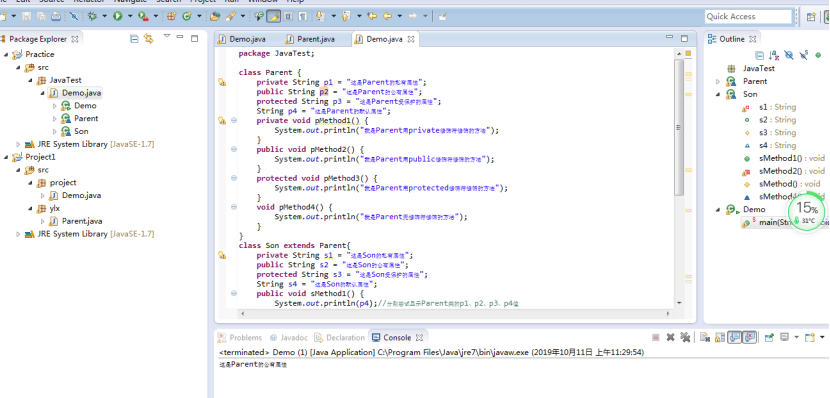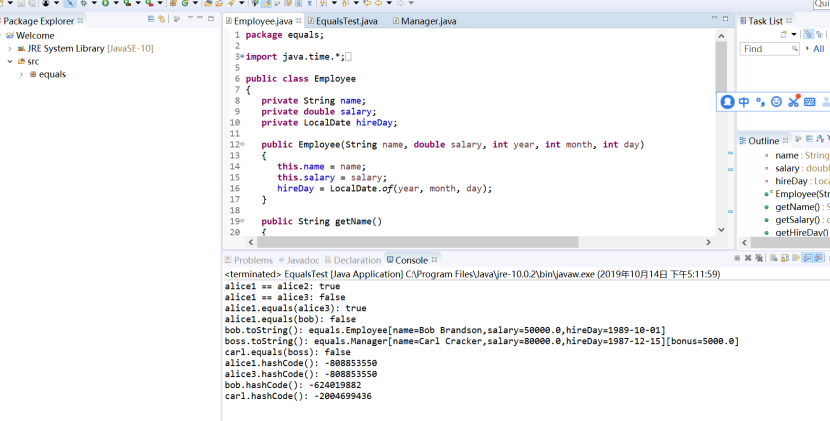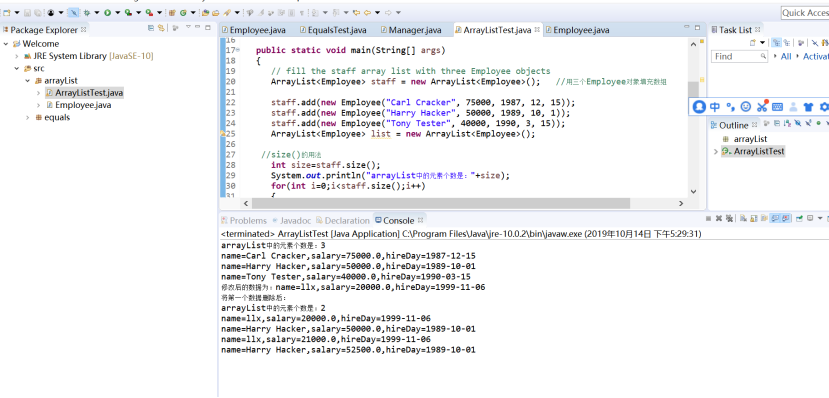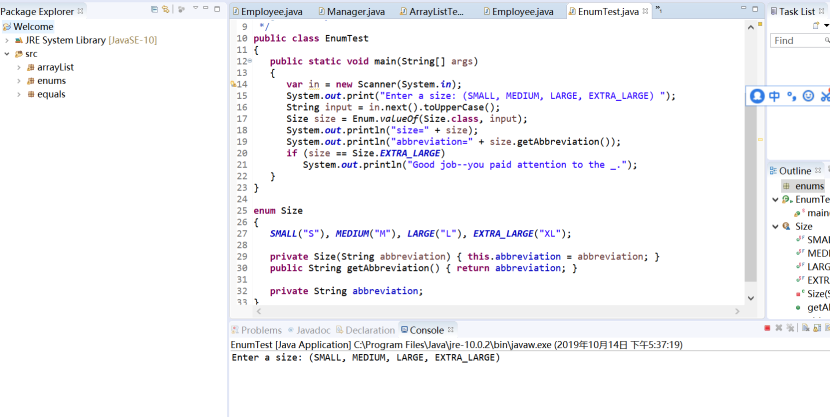201871010128-杨丽霞《面向对象程序设计(java)》第七周学习总
201871010128-杨丽霞-《面向对象程序设计(java)》第七周学习总结
|
项目 |
内容 |
|
这个作业属于哪个课程 |
https://www.cnblogs.com/nwnu-daizh/ |
|
这个作业的要求在哪里 |
https://www.cnblogs.com/nwnu-daizh/p/11654436.html |
|
作业学习目标 |
|
1、实验目的与要求
(1) 掌握四种访问权限修饰符的使用特点;
(2)掌握Object类的用途及常用API;
(3)掌握ArrayList类的定义方法及用法;
(4)掌握枚举类定义方法及用途;
(5)结合本章实验内容,理解继承与多态性两个面向对象程序设计特征,并体会其优点。
2、实验内容和步骤
实验1:在“System.out.println(...);”语句处按注释要求设计代码替换...,观察代码录入中IDE提示,以验证四种权限修饰符的用法。(20分)
实验代码如下:
class Parent {
private String p1 = "这是Parent的私有属性";
public String p2 = "这是Parent的公有属性";
protected String p3 = "这是Parent受保护的属性";
String p4 = "这是Parent的默认属性";
private void pMethod1() {
System.out.println("我是Parent用private修饰符修饰的方法");
}
public void pMethod2() {
System.out.println("我是Parent用public修饰符修饰的方法");
}
protected void pMethod3() {
System.out.println("我是Parent用protected修饰符修饰的方法");
}
void pMethod4() {
System.out.println("我是Parent无修饰符修饰的方法");
}
}
class Son extends Parent{
private String s1 = "这是Son的私有属性";
public String s2 = "这是Son的公有属性";
protected String s3 = "这是Son受保护的属性";
String s4 = "这是Son的默认属性";
public void sMethod1() {
System.out.println(...);//分别尝试显示Parent类的p1、p2、p3、p4值
System.out.println("我是Son用public修饰符修饰的方法");
}
private void sMethod2() {
System.out.println("我是Son用private修饰符修饰的方法");
}
protected void sMethod() {
System.out.println("我是Son用protected修饰符修饰的方法");
}
void sMethod4() {
System.out.println("我是Son无修饰符修饰的方法");
}
}
public class Demo {
public static void main(String[] args) {
Parent parent=new Parent();
Son son=new Son();
System.out.println(...); //分别尝试用parent调用Paren类的方法、用son调用Son类的方法
}
}
运行结果如下:



四种权限修饰符分别为:
public protected (default) private
其中(default)并不是关键字,是什么都不写的情况
权限大小:public>protected>(default)>private
它们在以下四种情况下的具体权限表现为:

实验2:导入第5章以下示例程序,测试并进行代码注释。
测试程序1
运行教材程序5-8、5-9、5-10,结合程序运行结果理解程序(教材174页-177页);
删除程序中Employee类、Manager类中的equals()、hasCode()、toString()方法,背录删除方法,在代码录入中理解类中重写Object父类方法的技术要点。(15分)
程序5-8:
package equals; /**
* This program demonstrates the equals method.
* @version 1.12 2012-01-26
* @author Cay Horstmann
*/
public class EqualsTest
{
public static void main(String[] args)
{
var alice1 = new Employee("Alice Adams", , , , );
var alice2 = alice1;
var alice3 = new Employee("Alice Adams", , , , );
var bob = new Employee("Bob Brandson", , , , ); System.out.println("alice1 == alice2: " + (alice1 == alice2)); System.out.println("alice1 == alice3: " + (alice1 == alice3)); System.out.println("alice1.equals(alice3): " + alice1.equals(alice3)); System.out.println("alice1.equals(bob): " + alice1.equals(bob)); System.out.println("bob.toString(): " + bob); var carl = new Manager("Carl Cracker", , , , );
var boss = new Manager("Carl Cracker", , , , );
boss.setBonus();
System.out.println("boss.toString(): " + boss);
System.out.println("carl.equals(boss): " + carl.equals(boss));
System.out.println("alice1.hashCode(): " + alice1.hashCode());
System.out.println("alice3.hashCode(): " + alice3.hashCode());
System.out.println("bob.hashCode(): " + bob.hashCode());
System.out.println("carl.hashCode(): " + carl.hashCode());
}
}
程序5-9:
package equals; import java.time.*;
import java.util.Objects; public class Employee
{
private String name;
private double salary;
private LocalDate hireDay; public Employee(String name, double salary, int year, int month, int day)
{
this.name = name;
this.salary = salary;
hireDay = LocalDate.of(year, month, day);
} public String getName()
{
return name;
} public double getSalary()
{
return salary;
} public LocalDate getHireDay()
{
return hireDay;
} public void raiseSalary(double byPercent)
{
double raise = salary * byPercent / ;
salary += raise;
} public boolean equals(Object otherObject)
{
// a quick test to see if the objects are identical
if (this == otherObject) return true; // must return false if the explicit parameter is null
if (otherObject == null) return false; // if the classes don't match, they can't be equal
if (getClass() != otherObject.getClass()) return false; // now we know otherObject is a non-null Employee
var other = (Employee) otherObject; // test whether the fields have identical values
return Objects.equals(name, other.name)
&& salary == other.salary && Objects.equals(hireDay, other.hireDay);
} public int hashCode()
{
return Objects.hash(name, salary, hireDay);
} public String toString()
{
return getClass().getName() + "[name=" + name + ",salary=" + salary + ",hireDay="
+ hireDay + "]";
}
}
程序5-10:
package equals; public class Manager extends Employee
{
private double bonus; public Manager(String name, double salary, int year, int month, int day)
{
super(name, salary, year, month, day);
bonus = ;
} public double getSalary()
{
double baseSalary = super.getSalary();
return baseSalary + bonus;
} public void setBonus(double bonus)
{
this.bonus = bonus;
} public boolean equals(Object otherObject)
{
if (!super.equals(otherObject)) return false;
var other = (Manager) otherObject;
// super.equals checked that this and other belong to the same class
return bonus == other.bonus;
} public int hashCode()
{
return java.util.Objects.hash(super.hashCode(), bonus);
} public String toString()
{
return super.toString() + "[bonus=" + bonus + "]";
}
}
运行结果如下:

删除程序中Employee类、Manager类中的equals()、hasCode()、toString()方法,背录删除方法后的代码:
Employee类
package equals; import java.time.*;
import java.util.Objects; public class Employee
{
private String name; //实例域定义
private double salary;
private LocalDate hireDay; public Employee(String name, double salary, int year, int month, int day)//构造器定义
{
this.name = name;
this.salary = salary;
hireDay = LocalDate.of(year, month, day);
}
public String getName() {
return name;
} public double getSalary() {
return salary;
} public LocalDate getHireDay() {
return hireDay;
}
public void raiseSalary(double byPercent)
{
double raise=salary*byPercent/;
salary+=raise;
} @Override
public boolean equals(Object otherObject) {
// TODO Auto-generated method stub
if(this==otherObject) return true;
if(this==null) return false;
if(getClass() != otherObject.getClass()) return false;
Employee other=(Employee)otherObject;
return Objects.equals(name,other.name)&&salary == other.salary&&Objects.equals(hireDay,other.hireDay);
}
@Override
public int hashCode() {
// TODO Auto-generated method stub
return Objects.hash(name,salary,hireDay);
} @Override
public String toString() {
// TODO Auto-generated method stub
return getClass().getName()+"[name="+name+",salary="+salary+",hireday="+hireDay+"]";
} }
Manager类
package equals; public class Manager extends Employee
{
private double bonus;
public Manager(String name, double salary, int year, int month, int day) {
super(name, salary, year, month, day);
// TODO Auto-generated constructor stub
bonus = ;
}
public void setBonus(double bonus) {
this.bonus = bonus;
}
@Override
public double getSalary() {
// TODO Auto-generated method stub
double baseSalary= super.getSalary();
return baseSalary+bonus;
}
@Override
public boolean equals(Object otherObject) {
// TODO Auto-generated method stub
if(!super.equals(otherObject)) return false;
Manager other=(Manager)otherObject;
return bonus==other.bonus;
}
@Override
public int hashCode() {
// TODO Auto-generated method stub
return super.hashCode()+*new Double(bonus).hashCode();
}
@Override
public String toString() {
// TODO Auto-generated method stub
return super.toString()+"[bonus="+bonus+"]";
} }
运行结果:

测试程序2
l 在elipse IDE中调试运行程序5-11(教材182页),结合程序运行结果理解程序;
l 掌握ArrayList类的定义及用法;
l 在程序中相关代码处添加新知识的注释;
l 设计适当的代码,测试ArrayList类的set()、get()、remove()、size()等方法的用法。
程序5-11:
package arrayList; import java.util.*; /**
* This program demonstrates the ArrayList class.
* @version 1.11 2012-01-26
* @author Cay Horstmann
*/
public class ArrayListTest
{
public static void main(String[] args)
{
// fill the staff array list with three Employee objects
var staff = new ArrayList<Employee>(); staff.add(new Employee("Carl Cracker", , , , ));
staff.add(new Employee("Harry Hacker", , , , ));
staff.add(new Employee("Tony Tester", , , , )); // raise everyone's salary by 5%
for (Employee e : staff)
e.raiseSalary(); // print out information about all Employee objects
for (Employee e : staff)
System.out.println("name=" + e.getName() + ",salary=" + e.getSalary() + ",hireDay="
+ e.getHireDay());
}
}
package arrayList; import java.time.*; public class Employee
{
private String name;
private double salary;
private LocalDate hireDay; public Employee(String name, double salary, int year, int month, int day)
{
this.name = name;
this.salary = salary;
hireDay = LocalDate.of(year, month, day);
} public String getName()
{
return name;
} public double getSalary()
{
return salary;
} public LocalDate getHireDay()
{
return hireDay;
} public void raiseSalary(double byPercent)
{
double raise = salary * byPercent / ;
salary += raise;
}
}
运行结果:

设计适当的代码,测试ArrayList类的set()、get()、remove()、size()等方法的用法
代码如下:
ackage arrayList; import java.util.*; /**
* This program demonstrates the ArrayList class.
* @version 1.11 2012-01-26
* @author Cay Horstmann
*/
public class ArrayListTest
{
private static final Employee element = null;
private static final int index = ; public static void main(String[] args)
{
// fill the staff array list with three Employee objects
ArrayList<Employee> staff = new ArrayList<Employee>(); //用三个Employee对象填充数组 staff.add(new Employee("Carl Cracker", , , , ));
staff.add(new Employee("Harry Hacker", , , , ));
staff.add(new Employee("Tony Tester", , , , ));
ArrayList<Employee> list = new ArrayList<Employee>(); //size()的用法
int size=staff.size();
System.out.println("arrayList中的元素个数是:"+size);
for(int i=;i<staff.size();i++)
{
//get()的用法
Employee e=staff.get(i);
System.out.println("name=" + e.getName() + ",salary=" + e.getSalary() + ",hireDay="
+ e.getHireDay());
}
//set()的用法
staff.set(, new Employee("llx", , , , ));
Employee e=staff.get();
System.out.println("修改后的数据为:name=" + e.getName() + ",salary=" + e.getSalary() + ",hireDay="
+ e.getHireDay()); //remove()的用法
staff.remove();
System.out.println("将第一个数据删除后:");
int size1=staff.size();
System.out.println("arrayList中的元素个数是:"+size1);
for(int i=;i<staff.size();i++)
{
Employee p=staff.get(i);
System.out.println("name=" + p.getName() + ",salary=" + p.getSalary() + ",hireDay="
+ p.getHireDay());
} // raise everyone's salary by 5%
for (Employee e1 : staff) //把每个人的薪资提高%5
e1.raiseSalary(); // print out information about all Employee objects
for (Employee e1 : staff) //输出所有雇员对象的信息
System.out.println("name=" + e1.getName() + ",salary=" + e1.getSalary() + ",hireDay="
+ e1.getHireDay()); //利用getName(),getSalary() 和getHireDay()方法输出所有雇员对象的信息
}
}
运行结果如下:

测试程序3
l 编辑、编译、调试运行程序5-12(教材189页),结合运行结果理解程序;
l 掌握枚举类的定义及用法;
l 在程序中相关代码处添加新知识的注释;
l 删除程序中Size枚举类,背录删除代码,在代码录入中掌握枚举类的定义要求。(15分)
程序5-12:
package enums; import java.util.*; /**
* This program demonstrates enumerated types.
* @version 1.0 2004-05-24
* @author Cay Horstmann
*/
public class EnumTest
{
public static void main(String[] args)
{
var in = new Scanner(System.in);
System.out.print("Enter a size: (SMALL, MEDIUM, LARGE, EXTRA_LARGE) ");
String input = in.next().toUpperCase();
Size size = Enum.valueOf(Size.class, input);
System.out.println("size=" + size);
System.out.println("abbreviation=" + size.getAbbreviation());
if (size == Size.EXTRA_LARGE)
System.out.println("Good job--you paid attention to the _.");
}
} enum Size
{
SMALL("S"), MEDIUM("M"), LARGE("L"), EXTRA_LARGE("XL"); private Size(String abbreviation) { this.abbreviation = abbreviation; }
public String getAbbreviation() { return abbreviation; } private String abbreviation;
}
删除程序中Size枚举类,背录删除代码
package enums; import java.util.*; /**
* This program demonstrates enumerated types.
* @version 1.0 2004-05-24
* @author Cay Horstmann
*/
public class EnumTest
{
public static void main(String[] args)
{
var in = new Scanner(System.in);
System.out.print("Enter a size: (SMALL, MEDIUM, LARGE, EXTRA_LARGE) ");
String input = in.next().toUpperCase();
Size size = Enum.valueOf(Size.class, input); //静态方法valueOf
System.out.println("size=" + size);
System.out.println("abbreviation=" + size.getAbbreviation());
if (size == Size.EXTRA_LARGE)
System.out.println("Good job--you paid attention to the _.");
}
}
//在枚举类型中添加一些构造器、方法和域
enum Size
{
SMALL("S"), MEDIUM("M"), LARGE("L"), EXTRA_LARGE("XL"); //实例名 private Size(String abbreviation) { this.abbreviation = abbreviation; }
@Override
public String toString() {
// TODO Auto-generated method stub
return super.toString();
} public String getAbbreviation() {
return abbreviation;
}
public void setAbbreviation(String abbreviation) {
this.abbreviation = abbreviation;
} private String abbreviation;
}
运行结果:

测试程序4 录入以下代码,结合程序运行结果了解方法的可变参数用法(5分)
public class TestVarArgus {
public static void dealArray(int... intArray){
for (int i : intArray)
System.out.print(i +" ");
System.out.println();
}
public static void main(String args[]){
dealArray();
dealArray();
dealArray(, , );
}
}
运行结果:

实验3 编程练习 参照输出样例补全程序,使程序输出结果与输出样例一致(10分)
public class Demo {
public static void main(String[] args) {
Son son = new Son();
son.method();
}
}
class Parent {
Parent() {
System.out.println("Parent's Constructor without parameter");
}
Parent(boolean b) {
System.out.println("Parent's Constructor with a boolean parameter");
}
public void method() {
System.out.println("Parent's method()");
}
}
class Son extends Parent {
//补全本类定义
}
Parent's Constructor with a boolean parameter
Son's Constructor without parameter
Son's method()
Parent's method()
修改后的代码如下:
public class Demo {
public static void main(String[] args) {
Son son = new Son();
son.method();
}
}
class Parent {
Parent() {
System.out.println("Parent's Constructor without parameter");
}
Parent(boolean b) {
System.out.println("Parent's Constructor with a boolean parameter");
}
public void method() {
System.out.println("Parent's method()");
}
}
class Son extends Parent {
Son(){
super(false);
System.out.println("Son's Constructor without parameter");
System.out.println("Son's method()");
}
}
运行结果:

3. 实验总结:
本次试验学习了访问修饰符有四种public protected 默认的不写的 private,public 访问权限最大,同包(同文件夹)里面的类绝对是可以互相访问的,不同包中的类只要经过import得到了路径后也是可以通过类的对象访问的,protected 和 默认的比public访问权限都要小(不能在其他包中被访问除非继承这里是指protected)但他们两之间有细微的区别就是在不同包中的类继承protected和 默认的时候 ,继承的类能够访问用protected修饰的成员而不能访问默认即不写修饰符的成员,private 范围最小 只能在类内部的成员之间进行访问,外部的类是绝对没有办法通过对象访问到私有成员的,继承的类也不会继承private的成员在Java中,ArrayList类可以解决运行时动态更改数组的问题。ArrayList使用起来有点像数组,但是在添加或删除元素时,具有自动调节数组容量的功能,而不需要为此编写任何代码。在今后的学习中要多思考,多去理解代码,理解各种参数的使用方法。
201871010128-杨丽霞《面向对象程序设计(java)》第七周学习总的更多相关文章
- 201771010134杨其菊《面向对象程序设计java》第九周学习总结
第九周学习总结 第一部分:理论知识 异常.断言和调试.日志 1.捕获 ...
- 201871010132-张潇潇《面向对象程序设计(java)》第一周学习总结
面向对象程序设计(Java) 博文正文开头 项目 内容 这个作业属于哪个课程 https://www.cnblogs.com/nwnu-daizh/ 这个作业的要求在哪里 https://www.cn ...
- 扎西平措 201571030332《面向对象程序设计 Java 》第一周学习总结
<面向对象程序设计(java)>第一周学习总结 正文开头: 项目 内容 这个作业属于哪个课程 https://www.cnblogs.com/nwnu-daizh/ 这个作业的要求在哪里 ...
- # 20155337 2016-2017-2 《Java程序设计》第五周学习总
20155337 2016-2017-2 <Java程序设计>第五周学习总结 教材学习内容总结 第八章 •语法与继承架构 •使用try.catch •特点: 使用try.catch语法,J ...
- 杨其菊201771010134《面向对象程序设计Java》第二周学习总结
第三章 Java基本程序设计结构 第一部分:(理论知识部分) 本章主要学习:基本内容:数据类型:变量:运算符:类型转换,字符串,输入输出,控制流程,大数值以及数组. 1.基本概念: 1)标识符:由字母 ...
- 201871010124 王生涛《面向对象程序设计JAVA》第一周学习总结
项目 内容 这个作业属于哪个课程 https://www.cnblogs.com/nwnu-daizh/ 这个作业的要求在哪里 https://edu.cnblogs.com/campus/xbsf/ ...
- 201871010115——马北《面向对象程序设计JAVA》第二周学习总结
项目 内容 这个作业属于哪个课程 https://www.cnblogs.com/nwnu-daizh/ 这个作业的要求在哪里 https://www.cnblogs.com/nwnu-daizh/p ...
- 201777010217-金云馨《面向对象程序设计(Java)》第二周学习总结
项目 内容 这个作业属于哪个课程 https://www.cnblogs.com/nwnu-daizh/ 这个作业的要求在哪里 https://www.cnblogs.com/nwnu-daizh/p ...
- 201871010132——张潇潇《面向对象程序设计JAVA》第二周学习总结
项目 内容 这个作业属于哪个课程 https://www.cnblogs.com/nwnu-daizh/ 这个作业的要求在哪里 https://www.cnblogs.com/nwnu-daizh/p ...
随机推荐
- linux-zookeeper-kafka入门
公告:版权所有,违者必究 1.zookeeper安装 前提:先安装jdk,zookeeper运行依赖于java环境. (1.)下载安装包 http://mirror.bit.edu.cn/apache ...
- Paper | A Pseudo-Blind Convolutional Neural Network for the Reduction of Compression Artifacts
目录 非盲增强网络结构 训练目标 压缩系数预测子网络 网络结构 根据块QP判决结果得到帧QP预测结果 保持时序连续性 实验 发表在2019年TCSVT. 本文提出了一个兼具 预测压缩系数 和 非盲去压 ...
- Note | Ubuntu
目录 0. 教程 1. 安装 2. 系统 0. 教程 <Linux就该这么学>:https://www.cnblogs.com/RyanXing/p/9462850.html 1. 安装 ...
- [[: not found,Ubuntu修改默认sh为bash
写好的shell sh执行脚本报错[[: not found,改shell多麻烦,索性直接把电脑默认的dash改成使用bash 1.查看目前使用 Ubuntu版本默认sh都是使用的dash 执行 ls ...
- [2019BUAA软工助教]团队alpha得分总表
[2019BUAA软工助教]团队alpha得分总表 [2019BUAA软工助教]团队alpha得分总表 一.团队累计得分 累计得分图 得分总表 二.各项得分计算规则 介绍与采访 项目选择与NABCD ...
- 支付宝AopSdk在dotnet core下的实现
随着项目都迁移到了dotnet core下,阿里的支付宝也需要随着项目迁移.之前在.Net Framework下用到了阿里提供的AopSdk和F2FPay两个程序集,支付宝官方提供的只支持Framew ...
- touch.js - 移动设备上的手势识别与事件库
Touch.js 是移动设备上的手势识别与事件库, 由百度云Clouda团队维护,也是在百度内部广泛使用的开发工具.Touch.js手势库专为移动设备设计.Touch.js对于网页设计师来说,是一款不 ...
- NimSystem实现
题目 题目比较长,我直接放截图吧 简述 一个比较经典的类与对象的题目,三个类实现了一个比较简单的系统,具体的每个类的要求可以从上面的题目描述中看出(只要你有耐心读完..),不再赘述,代码如下 代码实现 ...
- javascript中的发布订阅模式与观察者模式
这里了解一下JavaScript中的发布订阅模式和观察者模式,观察者模式是24种基础设计模式之一. 设计模式的背景 设计模式并非是软件开发的专业术语,实际上设计模式最早诞生于建筑学. 设计模式的定义是 ...
- 生成 Visual Studio 中的代码的文档生成神器
当我们在团队开发中的时候,经常要给别人提供文档,有了这个工具,设置一下,一键生成.前提是你要写好xml注释. 这也是开源项目: https://sandcastle.codeplex.com/ 它就是 ...
